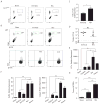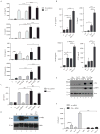Oral epithelial cells orchestrate innate type 17 responses to Candida albicans through the virulence factor candidalysin
- PMID: 29101209
- PMCID: PMC5881387
- DOI: 10.1126/sciimmunol.aam8834
Oral epithelial cells orchestrate innate type 17 responses to Candida albicans through the virulence factor candidalysin
Abstract
Candida albicans is a dimorphic commensal fungus that causes severe oral infections in immunodeficient patients. Invasion of C. albicans hyphae into oral epithelium is an essential virulence trait. Interleukin-17 (IL-17) signaling is required for both innate and adaptive immunity to C. albicans During the innate response, IL-17 is produced by γδ T cells and a poorly understood population of innate-acting CD4+ αβ T cell receptor (TCRαβ)+ cells, but only the TCRαβ+ cells expand during acute infection. Confirming the innate nature of these cells, the TCR was not detectably activated during the primary response, as evidenced by Nur77eGFP mice that report antigen-specific signaling through the TCR. Rather, the expansion of innate TCRαβ+ cells was driven by both intrinsic and extrinsic IL-1R signaling. Unexpectedly, there was no requirement for CCR6/CCL20-dependent recruitment or prototypical fungal pattern recognition receptors. However, C. albicans mutants that cannot switch from yeast to hyphae showed impaired TCRαβ+ cell proliferation and Il17a expression. This prompted us to assess the role of candidalysin, a hyphal-associated peptide that damages oral epithelial cells and triggers production of inflammatory cytokines including IL-1. Candidalysin-deficient strains failed to up-regulate Il17a or drive the proliferation of innate TCRαβ+ cells. Moreover, candidalysin signaled synergistically with IL-17, which further augmented the expression of IL-1α/β and other cytokines. Thus, IL-17 and C. albicans, via secreted candidalysin, amplify inflammation in a self-reinforcing feed-forward loop. These findings challenge the paradigm that hyphal formation per se is required for the oral innate response and demonstrate that establishment of IL-1- and IL-17-dependent innate immunity is induced by tissue-damaging hyphae.
Copyright © 2017 The Authors, some rights reserved; exclusive licensee American Association for the Advancement of Science. No claim to original U.S. Government Works.
Conflict of interest statement
Figures







Comment in
-
Candidalysin sets off the innate alarm.Sci Immunol. 2017 Nov 3;2(17):eaao5703. doi: 10.1126/sciimmunol.aao5703. Sci Immunol. 2017. PMID: 29101210 Free PMC article.
Similar articles
-
The adaptor CARD9 is required for adaptive but not innate immunity to oral mucosal Candida albicans infections.Infect Immun. 2014 Mar;82(3):1173-80. doi: 10.1128/IAI.01335-13. Epub 2013 Dec 30. Infect Immun. 2014. PMID: 24379290 Free PMC article.
-
IL-36 and IL-1/IL-17 Drive Immunity to Oral Candidiasis via Parallel Mechanisms.J Immunol. 2018 Jul 15;201(2):627-634. doi: 10.4049/jimmunol.1800515. Epub 2018 Jun 11. J Immunol. 2018. PMID: 29891557 Free PMC article.
-
Receptor-kinase EGFR-MAPK adaptor proteins mediate the epithelial response to Candida albicans via the cytolytic peptide toxin, candidalysin.J Biol Chem. 2022 Oct;298(10):102419. doi: 10.1016/j.jbc.2022.102419. Epub 2022 Aug 28. J Biol Chem. 2022. PMID: 36037968 Free PMC article.
-
Candidalysin biology and activation of host cells.mBio. 2025 Jun 11;16(6):e0060324. doi: 10.1128/mbio.00603-24. Epub 2025 Apr 28. mBio. 2025. PMID: 40293285 Free PMC article. Review.
-
Candidalysin: discovery and function in Candida albicans infections.Curr Opin Microbiol. 2019 Dec;52:100-109. doi: 10.1016/j.mib.2019.06.002. Epub 2019 Jul 6. Curr Opin Microbiol. 2019. PMID: 31288097 Free PMC article. Review.
Cited by
-
Variations in candidalysin amino acid sequence influence toxicity and host responses.mBio. 2024 Aug 14;15(8):e0335123. doi: 10.1128/mbio.03351-23. Epub 2024 Jul 2. mBio. 2024. PMID: 38953356 Free PMC article.
-
Immune regulation by fungal strain diversity in inflammatory bowel disease.Nature. 2022 Mar;603(7902):672-678. doi: 10.1038/s41586-022-04502-w. Epub 2022 Mar 16. Nature. 2022. PMID: 35296857 Free PMC article.
-
Some like it hot: Candida activation of inflammasomes.PLoS Pathog. 2020 Oct 29;16(10):e1008975. doi: 10.1371/journal.ppat.1008975. eCollection 2020 Oct. PLoS Pathog. 2020. PMID: 33119702 Free PMC article. No abstract available.
-
Fungal Toxins and Host Immune Responses.Front Microbiol. 2021 Apr 13;12:643639. doi: 10.3389/fmicb.2021.643639. eCollection 2021. Front Microbiol. 2021. PMID: 33927703 Free PMC article. Review.
-
Candida Infection as an Early Sign of Subsequent Sjögren's Syndrome: A Population-Based Matched Cohort Study.Front Med (Lausanne). 2022 Jan 21;8:796324. doi: 10.3389/fmed.2021.796324. eCollection 2021. Front Med (Lausanne). 2022. PMID: 35127751 Free PMC article.
References
MeSH terms
Substances
Grants and funding
LinkOut - more resources
Full Text Sources
Other Literature Sources
Medical
Molecular Biology Databases
Research Materials

